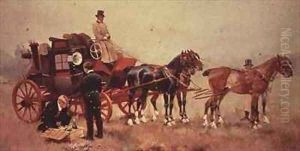Josep Cusachs y Cusachs Paintings
Josep Cusachs i Cusachs was a prominent Catalan painter, known for his distinctive contributions to the world of art in the late 19th and early 20th centuries. Born in 1851 in Barcelona, Spain, he emerged as a significant figure within the Catalan art scene, capturing the attention of both critics and the public alike with his unique approach to painting. Cusachs was adept in various genres, including military scenes, equestrian portraits, and landscapes, showcasing a versatility that made him a respected figure among his contemporaries.
Cusachs received his artistic training at the Escola de la Llotja in Barcelona, where he was influenced by the prevailing artistic movements of the time, as well as by his travels across Europe. His style evolved over the years, initially drawing inspiration from Romanticism and later incorporating elements of Impressionism, which allowed him to experiment with light and color in innovative ways. Despite these influences, Cusachs maintained a personal and identifiable style that was characterized by dynamic compositions, a bold use of color, and a distinctive ability to capture movement and emotion.
Throughout his career, Josep Cusachs participated in numerous exhibitions, both in Spain and abroad, gaining recognition and accolades for his work. His paintings were celebrated for their vibrancy and vitality, as well as for their ability to convey the spirit of the subjects he depicted. Cusachs's contributions to the art world were not limited to his paintings; he also played a role in the cultural life of Barcelona, engaging with literary and artistic circles that helped shape the cultural landscape of the city in the late 19th century.
Josep Cusachs passed away in 1908, leaving behind a rich legacy that has continued to influence and inspire artists and art enthusiasts alike. His works are held in high regard and can be found in museums, galleries, and private collections around the world. Cusachs's ability to blend tradition with innovation made him a pivotal figure in the transition of Catalan art into the modern era, and his contributions to the field of painting have secured his place as one of the notable artists of his time.




